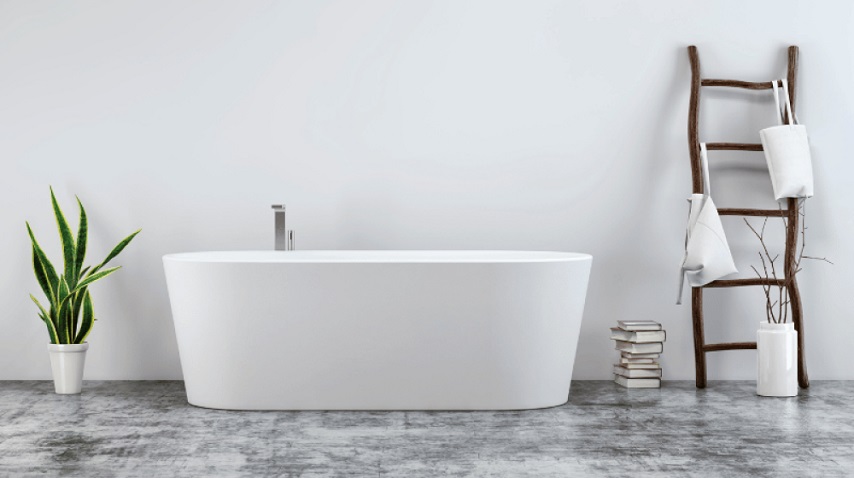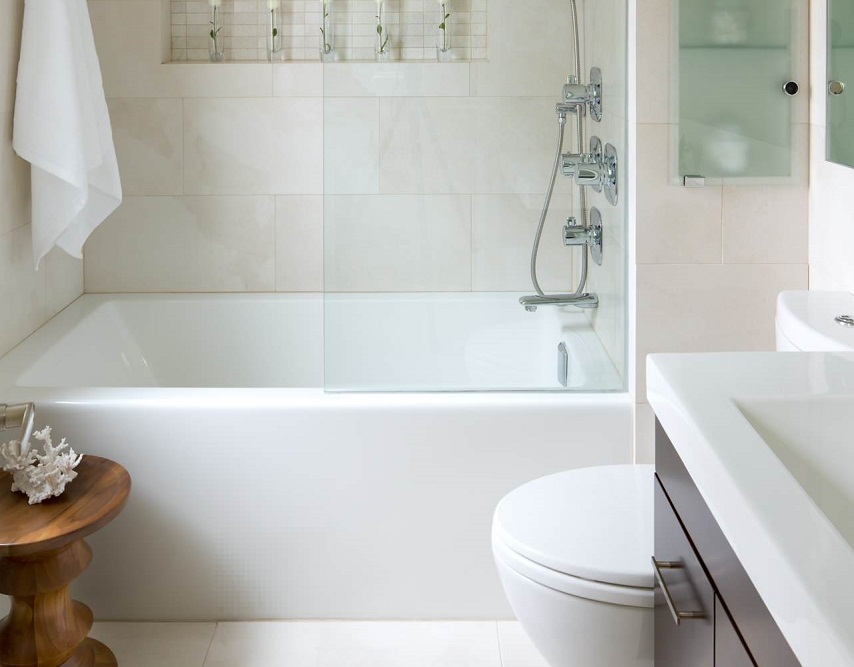Your bathroom should be a sanctuary – a place where beauty meets practicality. The right tub can transform this space into a luxurious retreat, tailored to your style and needs. With so many options available, each offers a blend of style and functionality. Read on to explore the diverse types of tubs that cater to every style, helping you discover the ideal choice to complement your space and enhance your daily routine.
Back to Wall

If you love the stylish look of a freestanding tub but need something more practical and space-saving, I recommend the space-efficient back to wall bathtubs as the fixtures that offer a sleek, modern design while sitting flush against the wall. This doesn’t only help save space but also makes them easier to clean.
Without any tricky corners to reach, maintaining these fixtures is much simpler. Plus, you’ll have access to a wider range of tapware and accessories to customise your space exactly how you like it. This combination of beauty and practicality makes these fixtures a great option for creating a chic and functional space.
One of the great things about a back to wall tub is its versatility. You can easily integrate it into various bathroom designs, whether you’re going for a chic, modern vibe or a more classic appearance. The wall-mounted design means you can choose from a range of styles and finishes to match your overall décor, from smooth, glossy surfaces to more textured options.
Plus, a back to wall bathtub will often include built-in features that enhance comfort and convenience, such as ergonomic backrests and easy-access controls. Imagine coming home after a long day and sinking into your bathtub, filled with warm water and your favourite essential oils.
The smooth, simple lines of the fixture complement the tranquil ambiance of your bathroom, creating the perfect setting for relaxation. You can unwind with a soothing bath, perhaps with a glass of wine in hand, enjoying the calming effects of the oils as they infuse the water. The space-efficient design enhances your comfort while also adding a touch of modern elegance to your bathroom retreat.
Freestanding
The freestanding design is a striking choice for those who want to make a statement in their bathroom. With its finished design on all sides, this tub comes in various styles and details, from elegant clawfoot models to sleek, modern bowl-like shapes. It’s often larger and more luxurious, providing a sense of grandeur and relaxation.
However, while this type adds a stylish touch, it may not be the best option for smaller bathrooms with limited floor space. Its generous size is perfect for long, indulgent soaks, but its depth and height can make it challenging for children or anyone with mobility issues to get in and out of comfortably. If you do have the space and enjoy a bit of luxury, however, a freestanding tub can transform your bathroom into a personal spa retreat.
Can I Put a Freestanding Tub Next to a Wall?
One of the great things about freestanding tubs is their versatility – you can place them almost anywhere in your bathroom. Whether you envision it in front of a mosaic or accent wall, by a window, on a pedestal, or even in the middle of the room, the design possibilities are truly endless.
However, if you’re thinking about installing your fixture close to a wall, it’s best to choose a back to wall tub. In case you’re going for a freestanding fixture, it’s generally recommended to leave at least 12 cm between it and the wall. This extra space allows for proper faucet installation and gives you room to clean between the fixture and the wall. If your faucet is mounted on the wall, you might be able to position the tub closer.
If you prefer a sleek look and a more practical setup, back to wall bathtubs are a much better option. They’re designed to sit flush against the wall, offering a clean, modern appearance while being easier to install and maintain. They provide a more seamless look if you’re looking to keep things simple and stylish.
Alcove

Another great option for your bathroom is an alcove bathtub. These fixtures are installed in a nook or recess, surrounded by walls on three sides. They often combine a tub and shower in one unit, making them a practical choice for spaces where you want to maximize functionality. If your bathroom design suits it, an alcove fixture can be a smart and efficient addition, offering both a relaxing bath and a convenient shower all in one.
Corner Tub
Corner tubs are a versatile choice for your bathroom, designed to fit neatly into a corner with one finished side facing out and two sides against the walls. They often feature a rounded or angular shape, which from above can look like a pentagon. While these fixtures are usually separate from the shower, some setups combine both for added convenience. Their unique design helps to make the most of corner spaces, giving your bathroom a stylish and functional layout.
Walk-In Tub
Walk-in tubs are ideal for seniors or anyone who finds it challenging to get in and out of traditional fixtures. They come equipped with a door, safety bars, and sometimes hydro-massaging features for added comfort. The door eliminates the need to step over a high ledge, which can be slippery and dangerous. However, one thing to keep in mind is that you’ll need to wait for the fixture to drain completely before you can open the door, so it requires a bit more patience compared to other styles.
Tub Materials
When choosing a bathtub, the material can make a big difference in durability, maintenance, and cost:
- Fibreglass: Affordable and low-maintenance but not the most durable. It can be prone to cracks, scratches, and discolouration over time;
- Acrylic: More durable and scratch-resistant than fibreglass, with many design options. However, it can be prone to warping and is generally more expensive;
- Porcelain-enamelled, cast iron or steel: Very long-lasting with a classic look. Steel is less expensive than cast iron, but both can be quite heavy and limited in design options;
- Cast polymer: Includes materials like cultured marble, which are durable and stain-resistant. While they resist scratches and stains well, cracks can be difficult to repair without visible marks.
